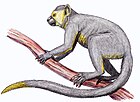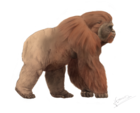Panina
In this article, we will delve into the exciting world of Panina, exploring its various aspects, characteristics and possible applications in everyday life. Panina is a topic that has aroused the interest of researchers, experts and enthusiasts, due to its relevance in different areas and its ability to influence our way of thinking, feeling and acting. Along these lines, we will analyze Panina from different perspectives, with the aim of offering a comprehensive and enriching vision that allows the reader to better understand its importance and potential. From its origins to its future projections, Panina reveals itself as an exciting topic that arouses curiosity and invites us to reflect on its impact on today's world.
| Panina Temporal range:
| |
|---|---|

| |
| A male chimpanzee (left) and a male bonobo (right) | |

| |
| Phylogeny of Panina including the ghost lineage and Sahelanthropus. | |
| Scientific classification | |
| Domain: | Eukaryota |
| Kingdom: | Animalia |
| Phylum: | Chordata |
| Class: | Mammalia |
| Order: | Primates |
| Suborder: | Haplorhini |
| Infraorder: | Simiiformes |
| Family: | Hominidae |
| Subfamily: | Homininae |
| Tribe: | Hominini |
| Subtribe: | Panina Delson, 1977[1] |
| Type genus | |
| Pan Blumenbach, 1775
| |
| Genera | |
Panina[2] is a subtribe of tribe Hominini; it comprises all descendants of the human-chimpanzee last common ancestor (LCA) that are not of the branch of human lineage—that is, all those ancestors of the type genus Pan (chimpanzees and bonobos).[3][1] This split/divergence occurred around 8 to 6 million years ago (mya),[4] which compares with a range of other estimates for this event—likely extended by periods of hybridization—of from 15 to 3 mya.[5][6] Fossils from this subtribe are typically rare because they tend to live in environments with poor fossilization. Some of the earliest chimpanzee fossils are 500,000 years of age.[7]
Classification
Panina is one of two subtribes of tribe Hominini; the other is Australopithecina (or Hominina). The genus Sahelanthropus lived around the time of the divergence, and may have then been found among one of these groups: a member of either branch of lineage; a precursor to both lineages; or possibly an early member of tribe Gorillini, which previously had split from the human-chimpanzee lineage. Regardless, the morphology of S. tchadensis supports the theory that, at and after the divergence, hominins then are unlikely to resemble in appearance(s) with any number of derived characters of their descendants.[8][9] A genetic study conducted in 2010 surveyed chimpanzee mitochondrial genomes and discovered the presence of an extinct ghost lineage, (i.e., fossil evidence doesn't exist yet) of Panina that diverged around 3.3 mya and began interbreeding with bonobos (Pan paniscus), who then interbred with chimpanzees (Pan troglodytes). This signature is carried more heavily in P. troglodytes despite having interbred with bonobos first, seeing as how they occupy a greater range.[10]
See also
References
- ^ a b Delson, Eric (1977). "Catarrhine phylogeny and classification: Principles, methods and comments". Journal of Human Evolution. 6 (5): 433–459. doi:10.1016/S0047-2484(77)80057-2.
- ^ Panina at Fossilworks.org
- ^ Harrison, T. (2010), "Dendropithecoidea, Proconsuloidea, and Hominoidea", Cenozoic Mammals of Africa, pp. 429–470, doi:10.1525/california/9780520257214.003.0024, ISBN 9780520257214
- ^ Dolhinow, Phyllis; Sarich, Vincent (1971). Background for Man. Little, Brown & Co. p. 76. ISBN 9780512246967.
- ^ ScienceNews.org – 'Hybrid-Driven Evolution: Genomes show complexity of human-chimp split: Not only did the evolutionary parting of human from chimpanzee ancestors occur more recently than had been indicated by previous data, but it also played out over an extended period during which forerunners of people and chimps interbred', Bruce Bower, Science News (May 20, 2006)
- ^ Patterson, N.; Richter, D. J.; Gnerre, S.; Lander, E. S.; Reich, D. (2006). "Genetic evidence for complex speciation of humans and chimpanzees". Nature. 441 (7097): 1103–1108. Bibcode:2006Natur.441.1103P. doi:10.1038/nature04789. PMID 16710306. S2CID 2325560.
- ^ Hopkin, M. (2005), "First chimp fossil unearthed", Nature, doi:10.1038/news050829-10
- ^ Guy, F.; Lieberman, D.E.; Pilbeam, D.; et al. (2005). "Morphological affinities of the Sahelanthropus tchadensis (Late Miocene hominid from Chad) cranium". PNAS. 102 (52): 18836–18841. Bibcode:2005PNAS..10218836G. doi:10.1073/pnas.0509564102. PMC 1323204. PMID 16380424.
- ^ Wolpoff, M. H.; Hawks, J.; Senut, B.; et al. (2006). "An Ape or the Ape : Is the Toumaï Cranium TM 266 a Hominid?" (PDF). PaleoAnthropology. 2006: 36–50.
- ^ Bjork, Adam; Liu, Weimin; Wertheim, Joel O.; Hahn, Beatrice H.; Worobey, Michael (2011), "Evolutionary History of Chimpanzees Inferred from Complete Mitochondrial Genomes", Molecular Biology and Evolution, 28: 615–623, doi:10.1093/molbev/msq227, PMC 3108604, PMID 20802239



